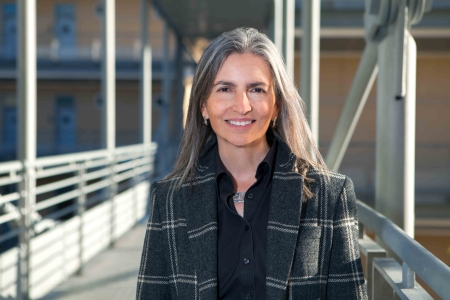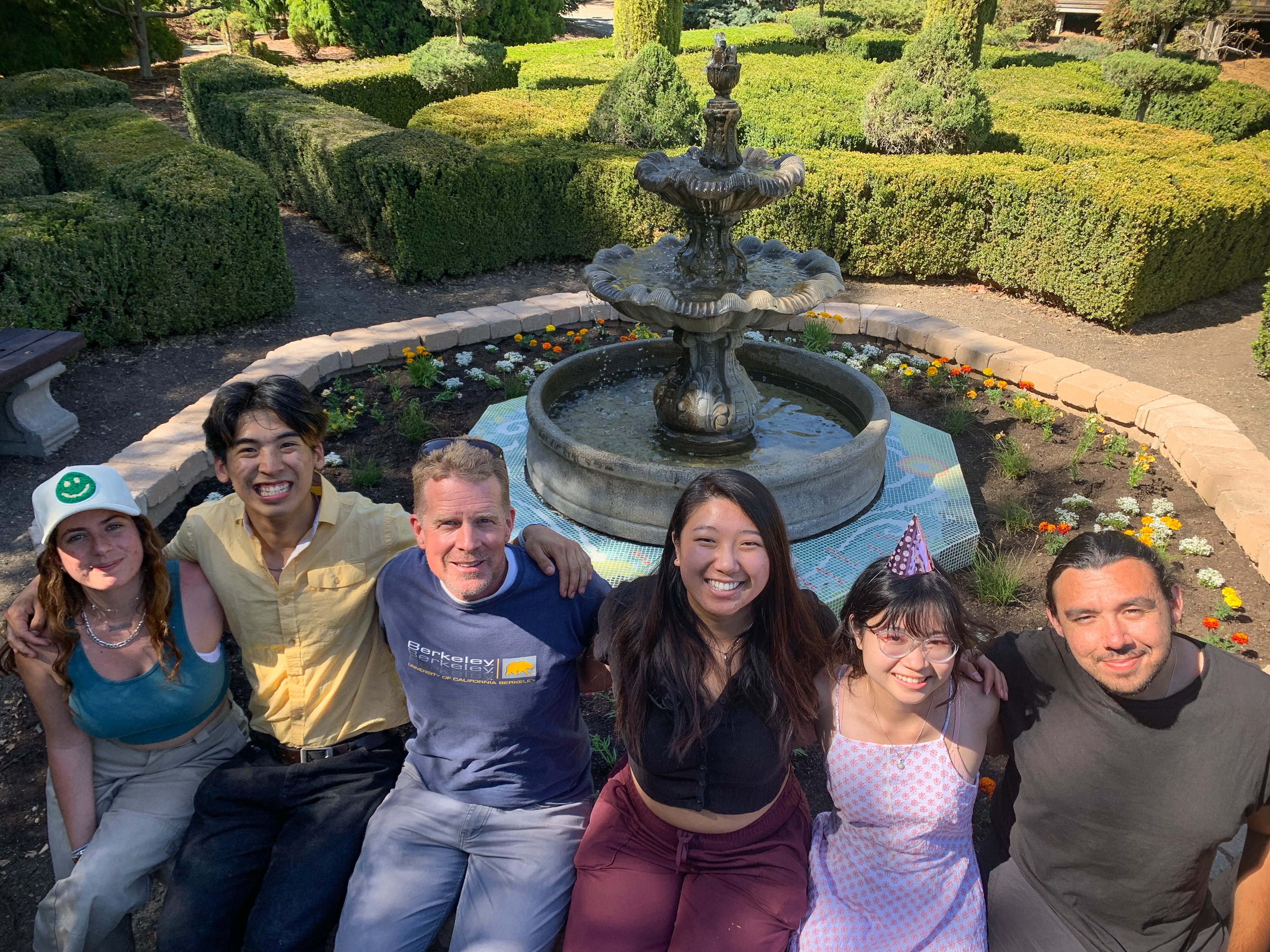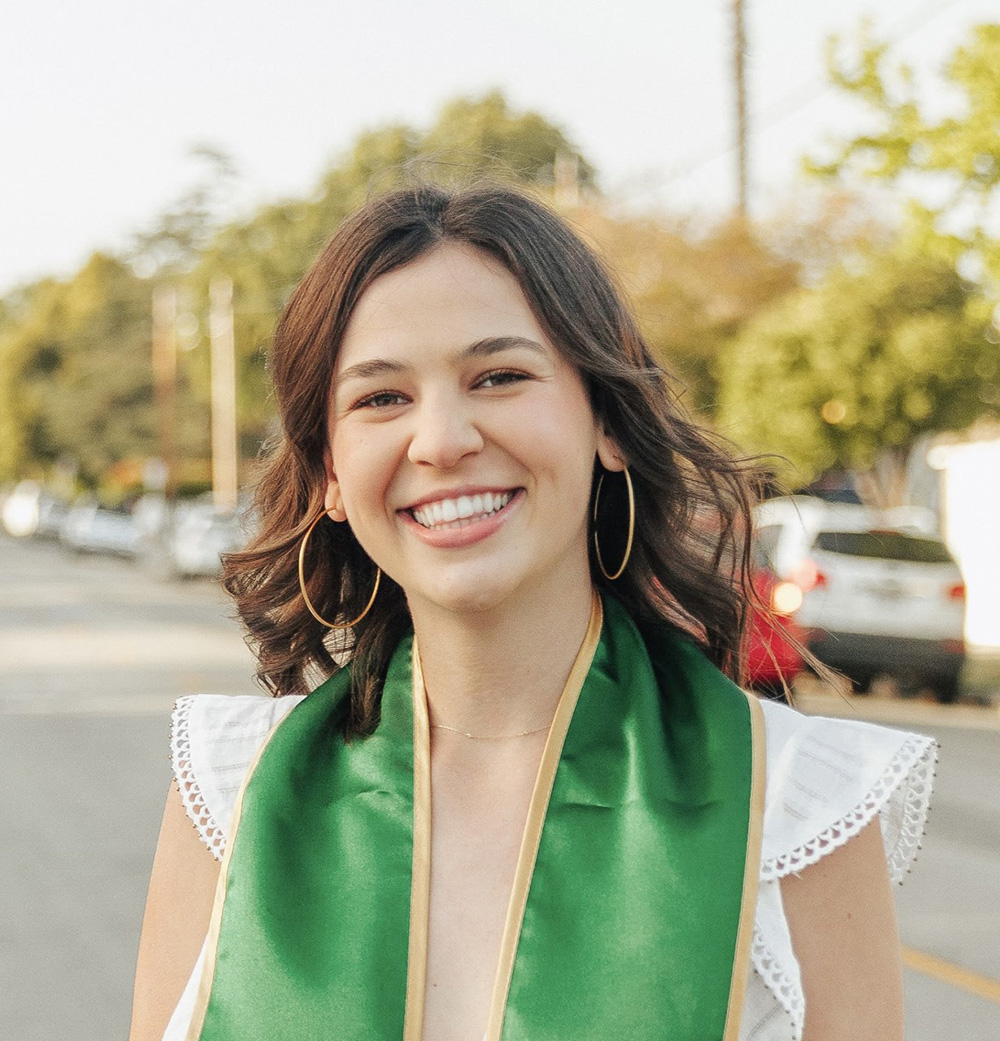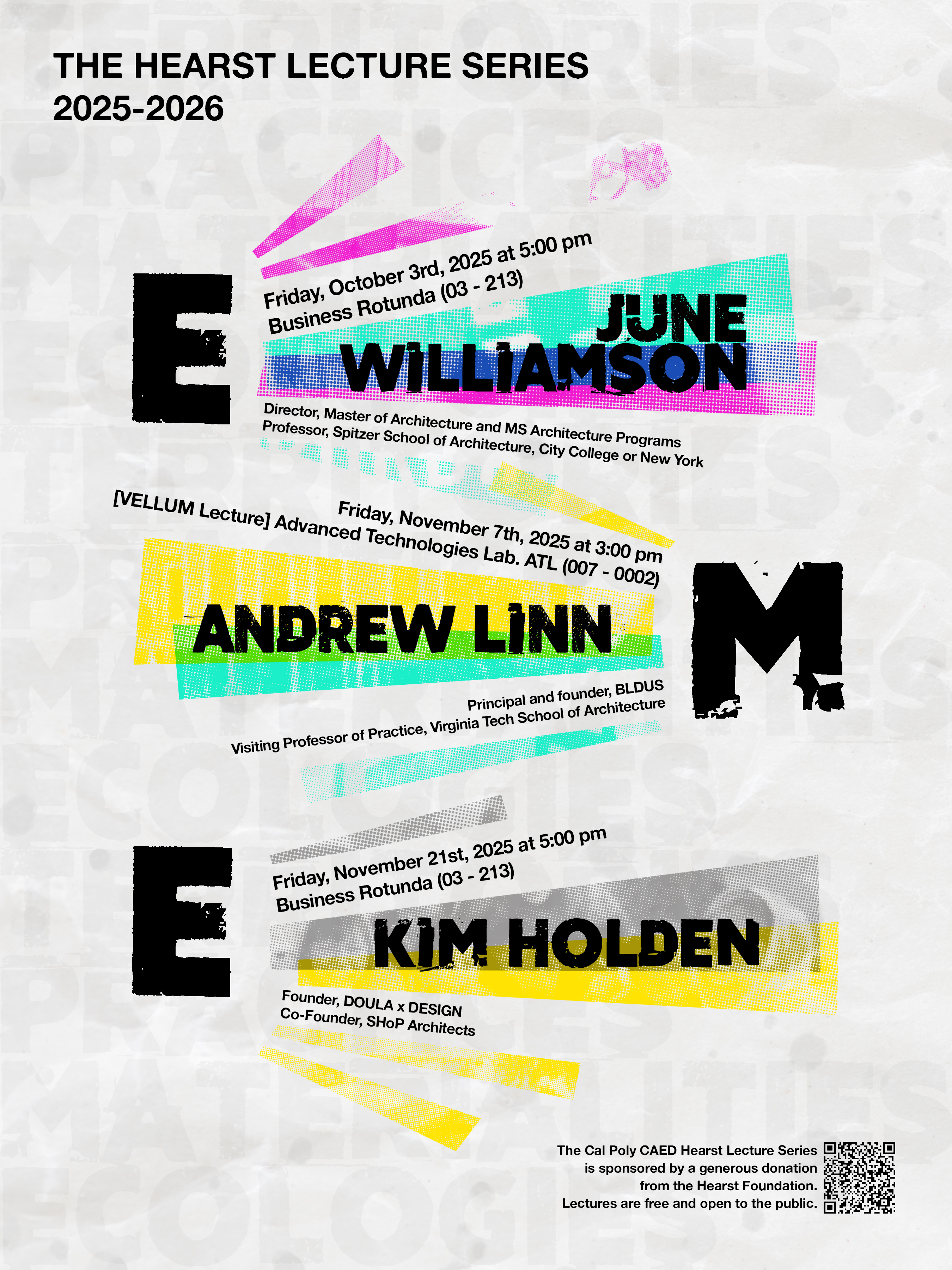News Archive: 2015-2023
CAED NEWS
POSTED: 24.01.24
 CAED Open House Schedule 2024
CAED Open House Schedule 2024
2023-2024 Academic Year
The College of Architecture and Environmental Design (CAED) welcomes you to the 31st annual Cal Poly Open House!
Having just celebrated our 75th anniversary, the CAED has established itself as one of the premier institutions in the nation, preparing students for leadership roles in the professions that plan, design, construct and steward the built environment. The college's interdisciplinary focus and low student-to-professor ratio enhance the school’s Learn by Doing ethos, which is the foundation of a well-rounded, quality education. CAED students engage in real-world community projects, collaborate with industry leaders and pursue local and international work experiences.
We are so excited to welcome admitted students, prospective students, alumni, and parents and supporters of CAED to Open House Weekend! Check out the open house schedule below and learn more about what Cal Poly CAED offers.
POSTED: 24.01.24
 City and Regional Planning Students Work to Shape California Communities
City and Regional Planning Students Work to Shape California Communities
2022-2023 Academic Year
Over recent months, Cal Poly's graduate and undergraduate Community and Regional Planning students have been deeply engaged in community projects in Desert Hot Springs and King City. Under Dr. Dave Amos, 15 second-year graduate students in the Community and Regional Planning Studio (CRP 552/554) collaborated with Desert Hot Springs to devise a downtown rehabilitation plan focused on economic development and pedestrian improvements. Their efforts included hands-on community engagement, gathering resident feedback, and hosting workshops. The final plan, presented to the city council in March 2023, proposed zoning revisions, pedestrian upgrades, and new city programs for economic stimulation.
Meanwhile, in King City, 18 fourth-year students in the Community Planning Lab (CRP 410/411), led by Dr. Kelly Main, worked on amending the city's comprehensive plan. Acknowledging King City's agricultural heritage and diverse cultural traditions, the students engaged in extensive community outreach through interactive activities, focus group meetings, and local event participation. Their strategic plan, comprising over 150 recommendations, aims to balance health, equity, and sustainability with the preservation of King City's unique character. This plan, set for presentation to the city's planning authorities, reflects a comprehensive approach to community-driven urban planning.
These initiatives, showcasing Cal Poly's commitment to practical, community-based education, highlight the need for continued financial support. While Desert Hot Springs funded its project, the King City endeavor was supported by the Errett Fisher Foundation Student Educational Enhancement Fund. This disparity underscores the challenge economically disadvantaged communities face in accessing quality planning services. The department's goal to extend its services to underprivileged areas hinges on securing more funding, emphasizing the importance of contributions to support these valuable student and community experiences.
POSTED: 24.01.24
 Christine Theodoropoulos, Dean of Renowned College of Architecture and Environmental Design, Announces Retirement
Christine Theodoropoulos, Dean of Renowned College of Architecture and Environmental Design, Announces Retirement
Novemeber 28, 2022
Contact: Keegan Koberl 805-458-9302; kkoberl@calpoly.edu
SAN LUIS OBISPO — Christine Theodoropoulos, dean of Cal Poly’s College of Architecture and Environmental Design (CAED), has announced her plans to retire from the university.
Theodoropoulos joined Cal Poly in 2012 as the first woman to serve as dean of the College of Architecture and Environmental Design. She is the second-longest-serving dean in the college’s 75-year history and the longest serving dean among the current leadership of Cal Poly’s six academic colleges.
Cynthia Jackson-Elmoore, Cal Poly’s provost and executive vice president for Academic Affairs, shared the news of Theodoropoulos’ impending retirement with the campus community Monday. “Dean Theodoropoulos’ interdisciplinary background and her interest in professional education that integrates architectural and structural design drew her to the CAED, where she found exciting opportunities emerging from the college’s tradition of symbiotic connections between programs in planning, design, engineering, and construction,” Jackson-Elmoore said. “Her work has elevated Cal Poly’s standing as a top-ranked school that prepares graduates to shape the built environment.”
Jackson-Elmoore shared that she will work with Theodoropoulos in the coming year while the university conducts a nationwide search for the college’s next dean and facilitates a leadership transition that ensures the continued success of the CAED community and positions the college for future achievements that will sustain the excellence of CAED programs. “It has been an honor and privilege to work with so many amazing members of the Cal Poly community over the past decade supporting our students and helping to shape the built environment of California and beyond,” Theodoropoulos said. “I am looking forward to continuing collaborative efforts serving communities, both locally and globally.”
During Theodoropoulos’ tenure as dean, the CAED strengthened faculty expertise and grew student enrollment while advancing the national recognition of its accredited programs. She formed a college leadership team that engaged the CAED community as it developed an academic masterplan and a diversity strategic plan, expanded the size and role of the Dean’s Leadership Council, and founded the college’s first DEI Committee. Through partnerships with the college’s academic departments, alumni, friends, and industry, she increased support for students with financial need, fostered new and increased access to career paths and co-curricular and global programs, and founded the CAED Teacher-and-Student-Scholar Grant Program.
A national leader in architectural education, Theodoropoulos has served as the chancellor of the ACSA College of Distinguished Professors; as the founding president of the Building Technology Educators Society; on the boards of the ACSA, the NAAB and AIA Oregon; and on numerous awards juries. Her extensive experience as an educational consultant, program reviewer and member of accreditation review teams has benefitted numerous architecture and design programs in the U.S. and abroad.
Theodoropoulos is a licensed architect and engineer in California. She earned a Master of Architecture degree at Yale University and a Bachelor of Science in Civil Engineering degree at Princeton University. She has been a member of architecture faculties at various institutions including Cal Poly Pomona, the University of Houston, and the University of Oregon, where she served as head of the Department of Architecture.
POSTED: 24.01.24
 Cal Poly Landscape Architecture Student Wins LAF’s Olmsted Scholar Award
Cal Poly Landscape Architecture Student Wins LAF’s Olmsted Scholar Award
2022-2023 Academic Year
Cal Poly's landscape architecture program has produced another outstanding talent in Maryam Abutabikh, who recently earned the prestigious Olmsted Scholar Award from the Landscape Architecture Foundation. Recognized for her leadership and dedication to sustainable, community-impacting design, Abutabikh's journey in landscape architecture began with a shift from architecture to creating community-engaging outdoor spaces. At Cal Poly, she was nurtured by faculty members Ellen Burke, Miran Day, and Cesar Torres, growing through a supportive, collaborative environment that honed her skills in critical thinking and environmental analysis.
Abutabikh's capstone project was a testament to her innovative approach, focusing on assisting Iraqi and Syrian refugees in El Cajon, San Diego. Inspired by her family's immigrant experience, she designed modular elements for El Cajon to foster inclusivity and meet the unique needs of the refugee community. This project showcased her ability to identify and address community challenges with thoughtful, practical landscape architecture solutions. Her recognition as an Olmsted Scholar underscores her commitment to impactful design and the potential for implementing her ideas in real-world scenarios.
Looking forward, Abutabikh plans to work with the city of San Diego to implement aspects of her capstone project. Despite a limited budget, she aims to create small but significant interventions, like outdoor kitchens and informational signage, to aid the community. Her journey is a shining example of Cal Poly's excellence in fostering landscape architects who are not only skilled designers but also empathetic community builders. As she embarks on her professional career, Abutabikh is poised to make a lasting impact in the field of landscape architecture, embodying the values and skills imparted by her mentors and her education at Cal Poly.
POSTED: 24.01.24
 Rain Garden Flourishes at Cal Poly
Rain Garden Flourishes at Cal Poly
2019-2020 academic year
SAN LUIS OBISPO – Cal Poly's Rain Garden Project: A Testament to Student Innovation and Sustainable Design
Cal Poly’s chapter of the Student Leadership in Green Infrastructure (SLGI), founded in 2016, exemplifies the integration of design, implementation, and maintenance in sustainable development. In the 2019-2020 academic year, under the guidance of landscape architecture faculty Ellen Burke and Joseph Ragsdale, students designed and built a rain garden next to building 26. This project, completed on a budget of under $5,000, showcased sustainable stormwater management practices and provided students with hands-on experience in resolving technical details like stormwater estimates and adapting to unexpected challenges, such as plant availability during the COVID-19 pandemic.
The project's second phase, led by faculty member Bret Betnar, focused on monitoring the garden's performance, including tracking soil salinity to assess the long-term impact on plant growth. Despite the challenge of limited funding and the expense of specialized equipment, students used sensors connected to an Arduino computer for data collection and monitored pollinator activity. The project was primarily funded by the Baker-Koob Endowments and the College of Architecture and Environmental Design, emphasizing the importance of financial support for sustainable, multi-year student projects.
The success of the SLGI rain garden project at Cal Poly highlights the importance of practical, hands-on learning in preparing students for real-world environmental challenges. Faculty like Burke envision further empowering students through investments in facilities like a hydrological modeling space and a working green roof model. As Burke asserts, funding landscape performance could position Cal Poly’s Landscape Architecture program as a leader in undergraduate studies, benefiting students and the state of California as it faces environmental changes in the coming decades. This project underlines the impact of 'Learn by Doing' philosophy, preparing students to be ready from day one in their professional careers.
POSTED: 24.01.24
 Landscape Construction Renovates Leaning Pine Arboretum Garden
Landscape Construction Renovates Leaning Pine Arboretum Garden
Spring Quarter, 2022
SAN LUIS OBISPO – LANDSCAPE ARCHITECTURE STUDENTS POSE WITH FACULTY MEMBER JOSEPH RAGSDALE FRONT OF THE COMPLETED PROJECT
Learn by Doing is a crucial principle behind everything taught at Cal Poly's College of Architecture and Environmental Design. From studying the conceptual and theoretical basis for design to preparing construction details at the end of a project, every student participates in a hands-on learning experience.
During the spring quarter of 2022, Advanced Landscape Construction faculty member Joseph Ragsdale took this philosophy a step further, tasking his class to design and construct a renovation for Leaning Pine Arboretum's formal garden.
While most landscape architecture professionals are not directly responsible for the construction of their designs, exposure to this design-build project is a valuable opportunity for students to learn about client reviews, budgeting, material selection, sustainability considerations, design documentation, construction techniques, and time management. By transforming their ideas from drawings to tangible landscape elements, students better understand related career opportunities outside the design studio, such as horticulture and construction management.
The class of 17 fourth- and fifth-year students were divided into four teams to complete the renovations for the arboretum. The students had to decide on appropriate elements to develop, working from a program and design ideas provided by the client, Arboretum Director Christopher Wassenberg. Students worked four hours a day twice weekly to construct the garden improvements. The teams created an entrance arbor, rebuilt a low wooden retaining wall, and added custom benches, a mosaic and some additional planting around the fountain's base. By the end of the spring quarter, the project was complete, and the garden was open for arboretum visitors
POSTED: 02.16.23
 MCRP/MS Student Receives U.S. Department of Transportation Student of the Year Award
MCRP/MS Student Receives U.S. Department of Transportation Student of the Year Award
JUNE 26, 2015
Contact: Charlotte Tallman 805-756-6402; ctallman@calpoly.edu
SAN LUIS OBISPO, Calif. — Cal Poly graduate student Peyton Ratto was honored with the Student of the Year award by the U.S. Department of Transportation. The Santa Clarita, California, resident was among 34 students nationwide to receive the title.
The award was presented in January by U.S. DOT’s University Transportation Centers Program (which awards grants to universities across the nation as it advances transportation research and technology and develops the next generation of transportation professionals) and the Council of University Transportation Centers. The council promotes university research, education, workforce development, and technology transfer as essential to the nation’s transportation system.
Graduate student Peyton Ratto Peyton Ratto will graduate from Cal Poly with dual master’s degrees in civil engineering and city and regional planning. Each Outstanding Student of the Year honoree is selected based on accomplishments such as technical merit and research, academic performance, professionalism, and leadership.
Ratto, who is pursuing dual masters’ degrees in civil engineering and city and regional planning, was nominated by civil engineering Professor Anurag Pande, who recognized her exemplary work on the book Pande was writing. Ratto added a section to help non-engineering students succeed in their math, physics, and statistics prerequisite courses.
“When I started the master’s program, Dr. Pande shared with me his textbook that would be developed as part of the ongoing U.S. Department of Education Open Education Resource project,” Ratto explained. “I enthusiastically jumped on board and co-authored the text that helps non-engineers get through the wall of prerequisites.”
Ratto, who earned a bachelor’s degree in City and Regional Planning in 2021 from Cal Poly, had a different perspective on the engineering-focused prerequisite coursework. She wanted to use her experience to help future students succeed in their lower-level classes.
“Coming from a non-engineering background, I took into consideration my struggles while taking the prerequisites alongside my first-year transportation engineering courses,” she said. “I researched the fundamental topics in math, physics, and statistics applicable to transportation engineering and created appropriate lesson plans to help those like me in the future.”
Pande said Ratto’s unique perspective would benefit non-engineering students in these undergraduate prerequisite courses.
“Her contributions, which are undoubtedly inspired by the challenges she faced in her prerequisite classes as a non-engineering student, have resulted in more engaging and useful content than an engineering professor — or any student with an engineering background — could have produced,” Pande said.
Ratto’s undergraduate and graduate courses have helped her excel.
“Cal Poly’s signature Learn by Doing pedagogy allowed me to develop skills in data analysis while developing general and specific plans for communities to apply them in real-world settings,” Ratto said.
After earning her planning degree, Ratto wanted to continue her education in the industry.
“I fell in love with my major,” she said. “I loved working toward the goal of helping the public, and I loved that I got to explore the interactions between different elements within a city.”
Ratto listed her co-authorship with Pande as her top accomplishment in 2022. She will work as a transportation analyst at Kittelson & Associates Inc., a civil engineering company in San Diego, after graduating later this year.



